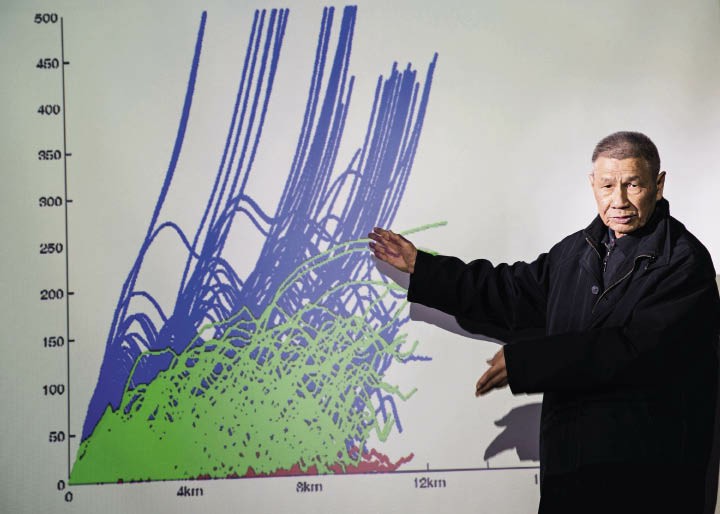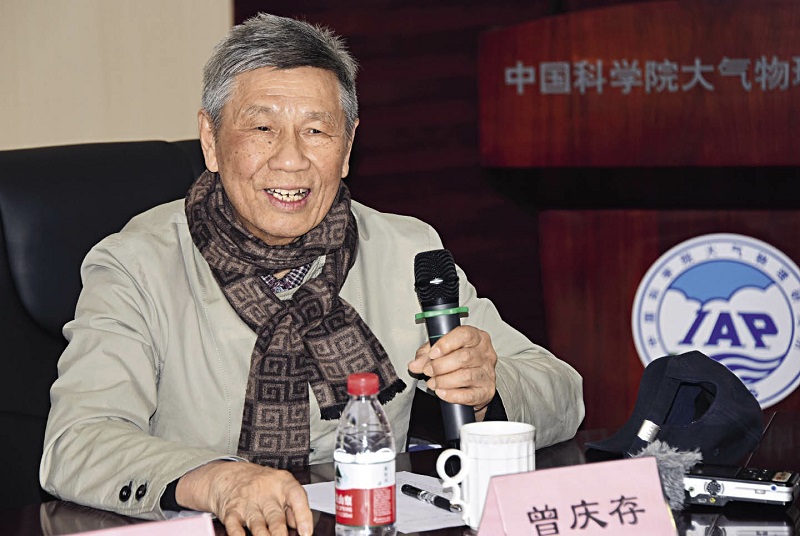On January 10, 2020, Chinese President Xi Jinping presented the State Preeminent Science and Technology Award, China’s top scientific honor, to Zeng Qingcun, a renowned atmospheric scientist and researcher at the Institute of Atmospheric Physics under the Chinese Academy of Sciences (CAS), for his outstanding contributions to scientific and technological innovation.

Zeng Qingcun is explaining a graphic on November 29, 2014.
Great Ambitions from Humble Beginnings
Zeng Qingcun was born into a poor farmer’s family in southern China’s Guangdong Province in 1935. Inspired by the headmaster of a local primary school, Zeng’s father enrolled his elder brother at the school. Since their parents were busy with farm work every day, the young Zeng was left unattended at home, so his brother took him along to school.
“When I was young, my brother and I wore ragged clothes and went barefoot to school. Every day we had to both do farm work and go to school,” said Zeng. But despite their hardships, their academic performance was always top of the class. The two boys’ academic prowess made them qualify to directly enter a junior high school upon graduation and go on to be awarded scholarships during their academic studies.
At 17, Zeng was admitted to the Department of Physics at Peking University in 1952, majoring in meteorology in compliance with the national need of the time. “I clearly remember one night in 1954 when frost froze 40 percent of growing wheat in Henan Province, seriously affecting the local grain production. If we had predicted the weather and taken precautions, we could have reduced the loss. I am sympathetic to farmers because I grew up in the countryside and know well harsh conditions there,” said Zeng.
Before graduation, Zeng was sent to the National Meteorological Center for an internship. He noticed that the weathermen laboriously analyzed and prepared weather forecasts using weather maps. However, due to the lack of refined calculations, they only used qualitative analysis and estimates based on their own experience.
“This inspired me to study the objective and quantitative numerical weather prediction to improve the accuracy of weather forecasting and strengthen our capacity to overcome natural disasters.”
From 1957 to 1961, Zeng was selected to attend the Institute of Geophysics of the Academy of Sciences of Soviet Union as a post-graduate under the supervision of Ilya Kibel, a distinguished mathematician and meteorologist at the Academy of Sciences of the Soviet Union. During his study there, he initiated the semi-implicit scheme, the first method of using simple equations in weather forecasting that has been widely accepted today.
After he returned home in 1961, he was assigned to work at the Department of Meteorology Research of the Institute of Geophysics and Meteorology under the CAS, where he began his career in scientific research.
Overcoming Challenges
Zeng concentrated on the subject of atmospheric sciences and geophysical fluid dynamics and the basic theories of numerical modeling in weather forecasting. “It seemed very abstract and divorced from the reality at that time. But later those theories proved to be important to the further development of numerical forecasting,” said Zeng, who has through pioneering and systematic research made contributions to his chosen areas of expertise.
In 1970, Zeng answered the call to assist national need again. He went to serve as the technical director at the Satellite Meteorological Group of the Joint Staff Department of the People’s Liberation Army.
When asked if he had any regrets about his 60-year-long scientific career, Zeng repeatedly mentioned that he failed to take care of his family. “Life was tough in the early days. I was in poor health and had to take frequent business trips; my brother was also seriously ill and needed surgery and nursing; while my wife and young child stayed behind in my poor countryside hometown. In a bid to concentrate on scientific research, I had no time to take care of my family,” said Zeng.
However, he has no regrets about contributing to scientific research. “There is no need to look back. I was born into a poor family in the rural area, and had to work like an adult in my youth. If it wasn’t for the founding of new China [in 1949], going to university would have been an unimaginable dream for me. I am sincerely grateful to the Communist Party of China and my country. The requirements of our nation have always been my first choice and the motivation for me to do further research,” said Zeng, adding, “Do not be afraid when you fall, get up and move forward.”
Zeng usually draws an analogy between climbing the world’s highest mountain Qomolangma and doing scientific research, to emphasize the perseverance and courage needed by his work.

Zeng Qingcun, a renowned atmospheric scientist and researcher with the Institute of Atmospheric Physics under the Chinese Academy of Sciences (CAS), at a seminar.
Unity Drives Creativity
In 1984, 49-year-old Zeng Qingcun took office as general director of the Institute of Atmospheric Physics under the CAS. At that time, conducting basic research in China in that field was extremely difficult. The institute lacked funding, office buildings, advanced laboratories, study rooms for postgraduates, equipment, and accommodations. In addition, the impact of unfair distribution of income during the process of dramatic economic restructuring and institutional reform also contributed to low staff morale. It was a tough time.
“What is the spirit of scientists? It is to contribute to the construction of our country, the future of our people, and the exploration of science,” said Zeng.
“Our institute, under the CAS leadership, is a national team for scientific research. We should strive to be a high level group by dauntlessly solving problems and looking far and wide into the future,” said Zeng. He also encouraged the team members to cooperate for the benefit of the whole nation by following the development trend of atmospheric physics. Under his leadership, the institute overcame the challenges of the time, including the reform of the science and technology management system, and moved forward to a period of great achievement.
During his nine years as the institute’s chief, two atmospheric science laboratories among the first batch of state key laboratories were established: The State Key Laboratory of Numerical Modeling for Atmospheric Sciences and Geophysical Fluid Dynamics (LASG) and State Key Laboratory of Atmospheric Boundary Layer Physics and Atmospheric Chemistry (LAPC).
“In the 1980s, the theoretical research of atmospheric science in China was not inferior to that of foreign countries. The difference was in advanced large computers, which were basically used in meteorological research across the globe. So we had to buy large computers, at all costs,” said Zeng. As a result of his unremitting efforts, the institute ultimately bought the largest computer in China at that time for further meteorological research.
In 1991, the institute established the International Center for Climate and Environment Sciences (ICCES), which was selected in 1995 as the representative center of China to join the network of Center of Excellence of Commission on Science and Technology for Sustainable Development in the South (COMSATS). In 2013, ICCES became CAS-TWAS (World Academy of Sciences for the advancement of science in developing countries) Center of Excellence for Climate and Environment Sciences. As an international research center, ICCES officially started to accept foreign doctoral candidates. Besides, it has since 2000 hosted the secretariat for the CAS-TWAS-WMO Forum jointly initiated by the CAS, TWAS, and the World Meteorological Organization, organizing international symposium and training workshops annually.
Under Zeng’s leadership, the two state key laboratories and ICCES have received international recognition, becoming the backbone of basic research of atmospheric science in China.
At present, the Earth system model is the premier research on global climate and environment change. Zeng is the pioneer and leader of China’s Earth system model and has participated in its specific design and development. In 2011, the CAS proposed to create the domestic Earth system model as an initial task while driving the construction of the Earth system numerical modeling vehicle, a major national scientific and technology infrastructure. In 2016, Zeng was approved as the founder and chief scientific director of this project.
Zeng’s scientific research has born fruit. Domestically, he has won two National Scientific Congress awards, two second prizes in China’s State Natural Sciences Awards, a Science and Technology Progress Award of the Ho Leung Ho Lee Foundation, and five first prizes at the CAS Natural Science Awards. In 2014, he was made an honorary member, the highest honor of the American Meteorological Society. In 2016, he was honored with the IMO Prize, the highest award of the World Meteorological Organization.
“I am fortunate that I have met so many nice teachers, classmates, supervisors, colleagues, friends, and students during my study and research career. All of them have helped me to make some useful innovations,” said Zeng. Although he is a world famous scientist, Zeng always feels grateful and respectful to his teachers and predecessors who taught and helped him throughout his life. When he talks about his achievements, he always modestly attributes the merits to other people.
Moreover, Zeng is hopeful about the future, “I am a ‘veteran’ in the field of meteorological research. I would like to dedicate myself to seeking truth and serving our country, and I wish the next generations can do the same.”